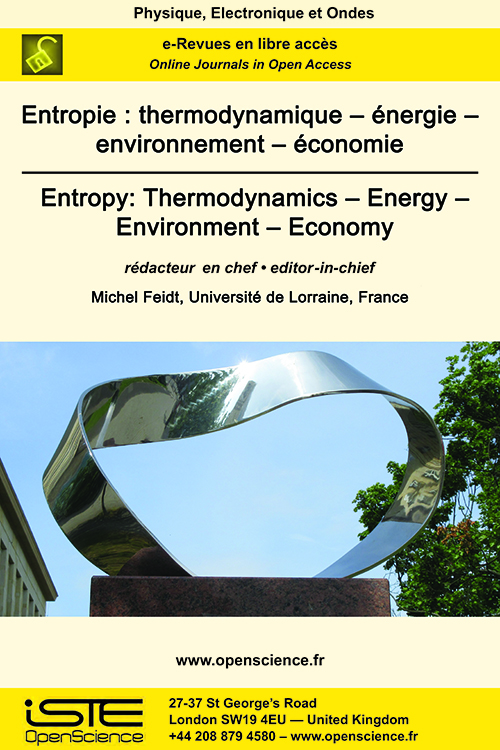

Physics > Home > Entropy: Thermodynamics – Energy – Environment – Economy > Issue
La Société Française de Thermique a pour objectif le développement et le rayonnement des sciences thermiques et énergétiques et de leurs applications concrètes. Cette année 2023, le 31ème Congrès Français de Thermique s’est déroulé du 30 Mai au 2 Juin 2023 à Reims sur le thème Thermique et Agroressources.
EAHE is an air-soil exchanger buried under the ground that permits the use of shallow ground temperatures to decrease building’s heating and cooling demands. Exergy analysis, which results from combining both the first and second law of thermodynamics, helps to analyze the performance of the EAHE at its reversible limit and to estimate the departure from this limit. An exergetic analysis will be carried out on the experimental EAHE installed at Illkirch-Graffenstaden campus of University of Strasbourg. The objective is to assess the system and identify the parts that dissipate energy the most to optimize the system. The experimental EAHE and the measurements taken are presented in the analysis and finally the derived results are analyzed.
In this paper, we examine a machine learning-based method aimed at improving the accuracy of T-LES fields in the context of highly anisothermal flows. We compare this method with an already existing super-resolution method. We train our convolutional neural network by filtering Direct Numerical Simulation (DNS) snapshots into T-LES ones, and optimize our network to reconstruct DNS small scales from T-LES snapshots. Our results show that the neural network outperforms the classical reconstruction method in terms of the quality of the reconstructed coherent structures, but ends up increasing the Root Mean Square (RMS) values over the DNS ones.
A semi-analytical thermal model of a MOSFET in unsteady regime is presented. It allows the calculation of the temperature of the top surface of the device from the temperature on the bottom surface and the heat flux on the top surface. The thermal quadrupole method coupled to a spectrum conversion is used to manage the interfaces between the different layers of the device. For a two-dimensional geometry, the comparison of the results of the semi-analytical model with numerical results (under COMSOL Multiphysics) shows a maximum deviation lower than 0.1 K for a 45 K temperature variation and allows an inter-validation of the models.
In Reunion Island, agricultural waste from pineapple cultivation and Furcraea Foetida (a pestilence also known as choka) are not currently valorized. In the construction sector, non-biosourced thermal insulation has a significant environmental impact, despite being essential for reducing the energy consumption of buildings. In this study, we are interested in the valorization of these waste products through fibers extraction for the production of loose-fill thermal insulation. The objectives are (i) to characterize choka leaf fibers, (ii) to evaluate the thermal conductivity of an insulator produced from choka fibers and (iii) to evaluate the thermal conductivity of a loose-fill insulator produced from pineapple leaf mash as a function of density. The minimum thermal conductivities obtained are 0.066 W/m.K for choka fiber insulation (density 0.022) and 0.058 W/m.K for pineapple leaf mash insulation (density 0.159).

2025
Volume 25- 6
Issue 12024
Volume 24- 5
Special issue LILA 22023
Volume 23- 4
Issue 12022
Volume 22- 3
Issue 12021
Volume 21- 2
Special issue2020
Volume 20- 1
Issue 1